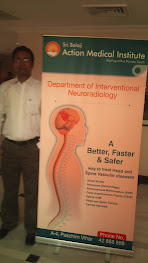10 years/f was asymptomatic 2 ½ yrs back when she started to get recurrent right partial seizure with secondary generalisations, more prominent in right lower limb.
Initially seizure frequency was 1-2 per month but it gradually increased to continuous tonic-clonic movement of right LL & UL.
There was also h/o weakness in right lower limb followng these seizures
No h/o weakness in right UL.
No h/o cognitive-visual hearing impairment.
No history of febrile seizures, head injury or febrile encephalopathy
EXAMINATION
Pulse-84/m; BP-100/76 mm Hg; Chest-NAD; CVS-NAD; ABDOMEN-NAD
NERVOUS SYSTEM
Higher mental function-conscious, oriented
Cranial nerve- Normal
Motor-RT UL 5/5, RT LL ankle 4/5 rest 5/5
Sensory- Normal
Investigations
Normal- Hemogram, LFT, RFT ,electrolytes,
CSF-Normal
ECG-Normal
EEG-Lateralization to left hemisphere
Chest x ray-Normal
Initial MRI was normal
A PET scan was done 5 months later, which showed hypometabolism in left temporal lobe and fronto-parietal operculum. Not that the corresponding CT slices are normal with not e/o altered attenuation or volume loss
MRI done one month later clearly showed signal alteration now
Follow up MRI a year later shows atrophy in the corresponding areas
Patient was admitted for evaluation . Patient had epilepsia partialis continua and her MRI was suggestive of Rasmussen’s encephalitis, so sugery was planned.
Risk of surgery was discussed with parents and it was decided to keep the patient on medical treatment.
Advice on discharge
Tab Clonazepam 10 mg BD, Tab Encorate chrono 200 mg 2-1-2, Tab Tegritol 200mg TDS, Tab Wysolone 35 mg OD PC, Tab Pantop 40 mg OD AC
DISCUSSION
Rasmussen encephalitis is a chronic, progressive encephalitis that results in severe, intractable epilepsy.
Seizures typically are the focal motor type and begin abruptly in previously normal children.
Characteristically, motor function deteriorates, often resulting in hemiparesis or hemiplegia as well as progressive cognitive decline .
In 1958, Rasmussen et al presented a series of 27 patients who had a syndrome characterized by the abrupt onset of intractable focal seizures; these were children with previously normal development
The etiology of Rasmussen encephalitis remains unknown. An initial hypothesis proposed infection with a slow viral agent.
More recent studies have suggested an autoimmune mechanism.
Destruction of neurons and astrocytes by cytotoxic CD8 T cells has been proposed as a pathogenic mechanism underlying this enigmatic disorder.
Histopathological findings in RE comprise lymphocytic infiltrates, microglial nodules, neuronal and astrocytic loss, and gliosis of the affected hemisphere
RE can be diagnosed if either all three criteria of Part A or two out of three criteria of Part B are present. Check first for the features of Part A. Then, if these are not fulfilled, of Part B. In addition: If no biopsy is performed, MRI with administration of gadolinium and cranial CT needs to be performed to document the absence of gadolinium enhancement and calcifications to exclude the differential diagnosis of a unihemispheric vasculitis.
PART A
1Clinical- Focal Seizures( with or witout epilepsia partialis continua) and unilateral cortical deficit
Unihemispheric slowing with or without epileptiform activity and unilateral seizure activity
Unilateral focal cortical activity and at least one of the following
Gray or White matter T2/FLAIR hyperintense signal
Hyperintense signal or atrophy of caudate head
PART B
Clinical-Epilepsia partialis continua or progressive unilateral cortical deficit(s)
MRI-Progressive and unihemispheric focal cortical atrophy
Histopathology- T cell dominated encephalitis with activated microglial cells (typically but not necessarily forming nodules )and reactive astrogliosis.
Numerous parenchymal macrophages, B cells or plasma cells or viral inclusion bodies exclude the diagnosis of Rasmussen’s encephalitis
Progressive means at least two sequential clinical or MRI studies are required to meet the respective criteria.
STAGING
STAGE 1-SWELLING/HYPERINTENSE SIGNAL
STAGE 2-NORMAL VOLUME/HYPERINTENSE SIGNAL
STAGE3-ATROPHY/HYPERINTENSE SIGNAL
STAGE4-PROGRESSIVE ATROPHY AND NORMAL SIGNAL
DIFFERENTIAL DIAGNOSIS
1. Unihemispheric epileptic syndromes
2 Epilepsia partialis continua (EPC) due to metabolic disorders
• Diabetes mellitus
• Renal or hepatic encephalopathy
3. Metabolic or degenerative progressive neurological disease
• MELAS and other mitrochondriopathies
4. Inflammatory/infectious diseases
Cerebral vasculitis in systemic connective tissue disease (e.g. lupus erythematosus) Unihemispheric cerebral vasculitis mimicking Rasmussen's encephalitis’:
Subacute sclerosing panencephalitis and other delayed subacute measles encephalitis with or without immunodeficiency
Paraneoplastic syndrome
Russian spring summer meningoencephalitis (RSSE)







 5:38:00 PM
5:38:00 PM
 Dr Subhash Kumar, MBBS, MD, DM
Dr Subhash Kumar, MBBS, MD, DM





